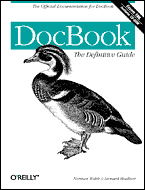DocBook: The Definitive Guide
 | By Norman Walsh & Leonard Muellner 1st Edition October 1999 1-56592-580-7, Order Number: 5807 652 pages, $36.95 , Includes CD-ROM |
| DocBook: The Definitive Guide | ||
|---|---|---|
| Prev | Next | |
Name
KeyCombo -- A combination of input actionsSynopsis
Content Model
KeyCombo ::= ((KeyCap|KeyCombo|KeySym|MouseButton)+)
Attributes
Common attributes
Name | Type | Default |
| OtherAction | CDATA | None |
| Action | Enumeration: Click | None |
| MoreInfo | Enumeration: None | "None" |
Tag Minimization
Both the start- and end-tags are required for this element.
Parameter Entities
Description
For actions that require multiple keystrokes, mouse actions, or other physical input selections, the KeyCombo element provides a wrapper for the entire set of events.
Processing expectations
Formatted inline. The MoreInfo attribute can help generate a link or query to retrieve additional information.
Parents
These elements contain KeyCombo: Action, Application, Attribution, BiblioMisc, BridgeHead, Citation, CiteTitle, Command, Comment, ComputerOutput, Database, Emphasis, entry, Filename, ForeignPhrase, FuncParams, FuncSynopsisInfo, Function, GlossSee, GlossSeeAlso, GlossTerm, Hardware, Interface, InterfaceDefinition, KeyCap, KeyCombo, LineAnnotation, Link, Literal, LiteralLayout, LoTentry, Member, MsgAud, OLink, Option, Optional, Para, Parameter, Phrase, Primary, PrimaryIE, ProductName, ProgramListing, Property, Quote, RefDescriptor, RefEntryTitle, RefName, RefPurpose, Screen, ScreenInfo, Secondary, SecondaryIE, See, SeeAlso, SeeAlsoIE, SeeIE, Seg, SegTitle, Shortcut, SimPara, Subtitle, Synopsis, SystemItem, Term, Tertiary, TertiaryIE, Title, TitleAbbrev, ToCback, ToCentry, ToCfront, Trademark, ULink, UserInput.